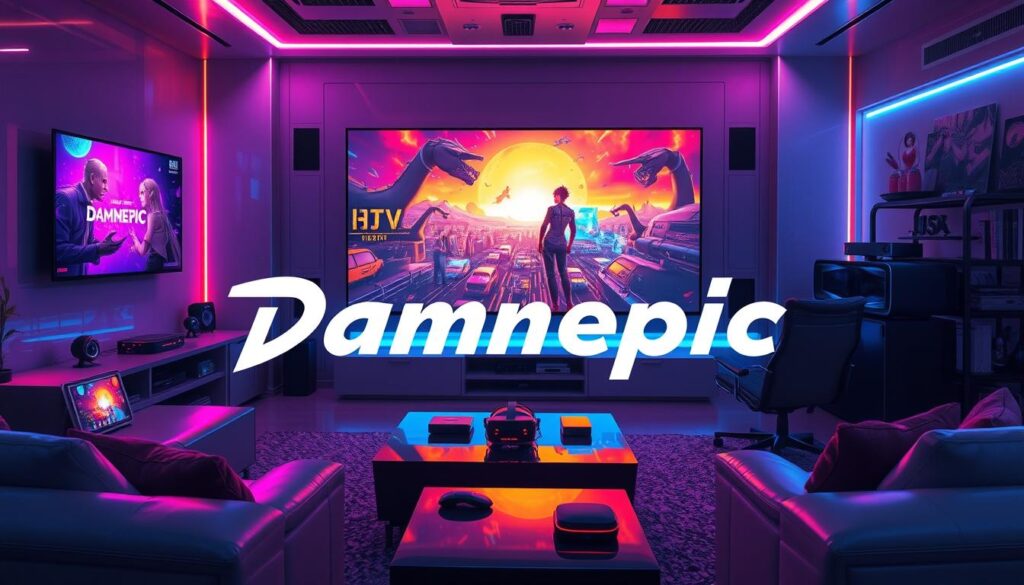As an avid anime fan, I’ve seen the streaming world change a lot in the last 20 years. We’ve moved from DVD rentals to a digital world. Netflix, once a DVD-by-mail service, is now a global leader in digital entertainment.
The early 2000s brought big changes with YouTube and Google’s $1.65 billion deal in 2006. Fast internet growth in the late 2000s made streaming popular. Netflix started streaming in 2007, and Hulu followed in 2008, starting the streaming wars.
Key Takeaways
- The streaming industry has transformed from DVD rentals to digital platforms, revolutionizing anime consumption.
- The rise of YouTube and the expansion of broadband internet in the late 2000s facilitated the growth of streaming platforms.
- Netflix and Hulu were early movers in the streaming market, setting the stage for the intensifying “streaming wars” in the years ahead.
- The global anime fan base is estimated to reach one billion, signifying the immense popularity and medium.
- Anime’s widespread influence can be seen in its references across various sports leagues and popular culture, transcending its Japanese roots.
The Evolution of Streaming Services: From DVDs to Digital Revolution
The world of entertainment has changed a lot. It moved from physical media to digital streaming. Netflix, a leader, changed how we watch shows and movies.
The Birth of Netflix and Early Innovations
Netflix started in 1998 by Reed Hastings and Marc Randolph. It was a DVD rental service. In September 1999, it became a subscription service, which was a big hit.
By 1999, Netflix made almost $300 million. This was thanks to a new way of renting movies without extra fees. This idea helped Netflix grow fast.
In February 2000, Netflix launched a program for unlimited movie rentals. It cost $19.95 a month. This move helped Netflix grow even more, making it a big name in streaming.
The Fall of Traditional Media Giants
At the same time, Netflix was growing, big names like Blockbuster were falling. In 2004, Blockbuster tried to compete online but failed. It brought back late fees, which hurt its business.
Blockbuster also faced pressure from investors. This made it harder for Blockbuster to keep up with Netflix’s new way of streaming.
The Rise of Digital Distribution
The 2000s were a big change for streaming tech. New ways to compress data and better internet made streaming possible. This changed how we watch TV and movies.
This change not only changed how we watch things but also changed the whole media world.

“The subscription model significantly contributed to Netflix’s exponential growth, as it eliminated per-movie, shipping, and late-fee charges for its subscribers.”
How Anime Streaming is Reshaping Global Entertainment
Anime streaming has changed the world of entertainment. Sites like Netflix, Crunchyroll, and Funimation have made anime available everywhere. This has led to a big increase in anime watching, with a 40% rise in streaming during the pandemic.
Netflix has been key in growing the anime world. It has made original anime and bought rights to hits like Naruto and One Piece. Crunchyroll offers dubbed and subtitled shows, making anime more accessible and engaging for fans worldwide.
Anime streaming has done more than just grow viewership. Anime events like San Diego Comic-Con have become big economic boosts, bringing in over $164 million in 2022. The anime market was worth $29 billion in 2022 and is expected to hit $72 billion by 2032.
Young people, mainly those 16-22, drive the anime craze. They shape social media and what they buy. Countries like Thailand and the US lead in anime merchandise sales.
Companies like Coca-Cola are teaming up with anime to attract young fans. Anime streaming has not only grown viewers but also brought fans together globally. This has created a vibrant community that goes beyond just watching shows.
| Anime Audience Breakdown | Gen Z | Millennials | Gen X |
|---|---|---|---|
| Weekly Anime Viewers | 42% | 25% | 12% |
| Black American Anime Fans | 23% | 17% | – |
| Asian American Anime Fans | 13% | 10% | – |
Anime streaming has dramatically changed global entertainment. As more people watch and platforms invest, the future of anime platforms, global entertainment, and the streaming wars looks very promising.

Major Players in the Anime Streaming Battlefield
The anime streaming world is very competitive. Big names like Netflix, Crunchyroll, and Amazon Prime Video are fighting for fans’ attention. Each has its own way to draw in anime lovers worldwide.
Netflix’s Strategic Investment in Anime
Netflix has really put its money into anime. It’s now the top place for anime fans globally. In March, it added new episodes of The Seven Deadly Sins and Pokémon Horizons: The Series. Fans get new episodes every week.
The first season of Black Clover started on Netflix on April 1, 2024. It also released three anime movies, including One Piece Film: Red.
Crunchyroll’s Specialized Approach
Crunchyroll focuses only on anime. It has almost 1,300 titles for anime lovers. Its deep connections in the anime world let it get exclusive rights to many series. It’s a top choice for serious fans.
Amazon Prime and Other Competitors
Amazon Prime Video is also big in anime, with a wide range of titles. New players like Hallmark+ aim at specific fans. BritBox and Shudder have grown their anime offerings too.
This competition has made anime streaming better and more varied. Now, fans can find everything from action to romance easily. It’s all available online.
Technology Innovations Driving the Streaming Revolution
The streaming world is leading in tech innovation, always finding new ways to deliver content and improve user experience. Advances like AI-powered recommendations and 4K and HDR streaming are changing how we watch entertainment.
YouTube is a key player in this innovation, introducing features like high-definition video and 360-degree streaming. These technologies not only make watching more engaging but also set new standards for digital content delivery.
Now, the industry is looking into using augmented and virtual reality in streaming. This could make watching shows and movies more interactive and immersive. It’s a step towards merging the digital and real worlds.
As streaming tech keeps advancing, the future of entertainment is being shaped. From tailored recommendations to VR experiences, the streaming revolution is changing how we enjoy content.
“The streaming industry is at the forefront of technological innovation, constantly pushing the boundaries of content delivery and user experience.”
But it’s not just about visuals. Streaming companies are using AI and machine learning to make recommendations better. This means viewers get content that fits their tastes and watching habits.
Looking ahead, we can expect even more exciting tech in streaming. Expect to see AR and VR become more integrated and advanced content discovery tools. The future of streaming is full of possibilities.
The Economics of Anime Streaming Platforms
Anime streaming has grown a lot, with many platforms trying to get more of the global entertainment market. The streaming wars are now about making money, not just getting more subscribers. Niche anime platforms have grown a lot, with a 27% increase in subscriptions in 2022. They use places like Amazon Prime to reach more people and make money from subscriptions.
Subscription Models and Revenue Streams
Anime streaming sites offer different subscription plans to meet the needs of their users. You can choose from monthly, yearly, or ad-free options. As the global entertainment world changes, these sites keep working on their prices to be fair and profitable.
Content Licensing and Original Productions
The anime world makes money from licensing and merchandising. But, big players like Netflix are focusing more on their own anime shows. Netflix plans to make more original anime, showing they’re serious about growing in this market.
Global Market Expansion
As anime platforms grow globally, they face challenges in licensing and distribution. With over 110 competitors, they’re looking for new ways to reach fans worldwide. Japan, China, and South Korea are key markets, thanks to their strong anime culture and creators.
The anime streaming world is competitive and growing fast. Platforms are trying new things to get more of the market. Success will depend on understanding what viewers want, keeping up with tech, and giving a great viewing experience to fans everywhere.
User Experience and Platform Features
As the anime streaming world grows, platforms focus more on improving user experience. They offer personalized recommendations and better ways to find content. This makes watching anime more fun and easy for fans.
The binge-watching trend, started by Netflix, has changed how we watch anime. But, some creators like the old way of releasing episodes weekly. This builds excitement and connects fans more deeply.
Platforms are adding features for viewers worldwide, like watching offline and in different languages. This makes sure everyone can enjoy their favorite anime, no matter where they are or what device they use.
But, platforms face a big challenge. They need to keep improving the user experience while handling more content. As more people want to binge-watch, platforms must keep updating their streaming tech to stay competitive.
“The user interface and overall experience are key to an anime streaming platform’s success. Platforms that focus on easy navigation, tailored suggestions, and smooth playback will win over and keep anime fans.”
By adding new features and improving their platforms, streaming services can make watching anime better. This leads to more fans engaging and staying loyal to the global anime community.
Content Strategy and Global Audience Engagement
In the world of anime streaming, new strategies are being used to attract viewers worldwide. Platforms are making content that fits different regions. This way, they connect with viewers on a deeper level.
Regional Content Adaptation
The Asia Pacific is the biggest market for anime outside Japan. But Europe and the Middle East are growing fast. Streaming services are adapting content for these areas to find new success.
For example, Netflix’s “Terminator Zero” and Disney+’s “Star Wars: Visions” mix American stories with anime. This creates exciting cross-cultural stories.
Localization and Cultural Considerations
Localization is more than just translating. It’s about understanding different cultures. Platforms are working hard to make content that feels right for viewers everywhere.
This careful approach makes anime more accessible and welcoming. It makes fans feel like they belong to a global community.
Fan Community Building
Fan communities are key to anime streaming’s success. Platforms are creating experiences that let fans share their love for anime. This builds a strong community of fans.
As the industry grows, the bond between streaming services and fans will be vital. It will help drive global entertainment forward.



